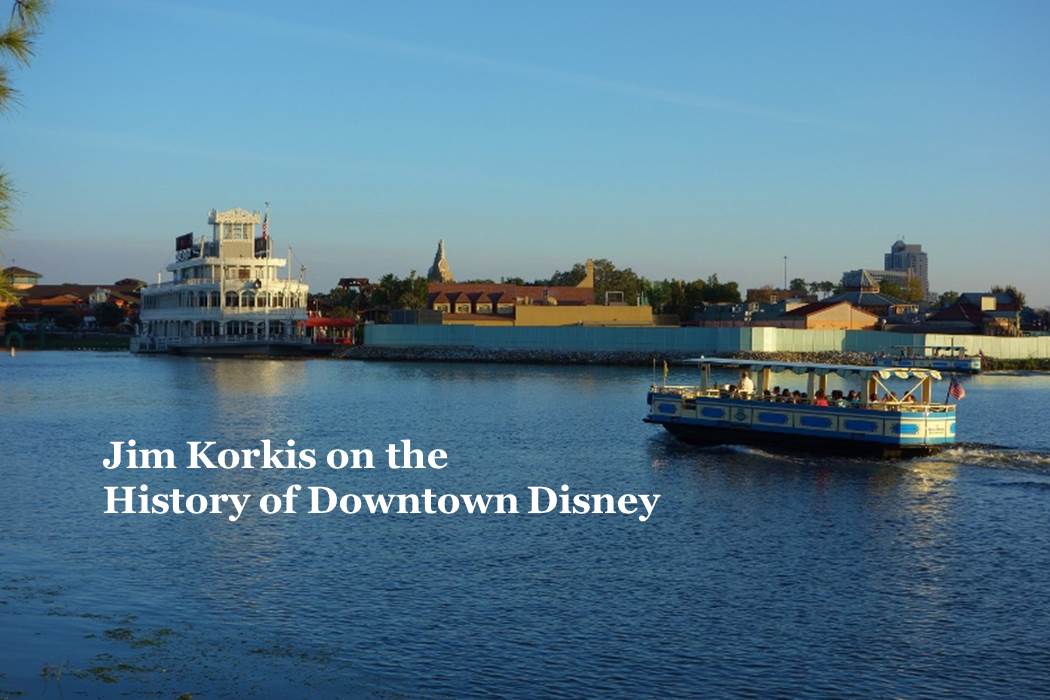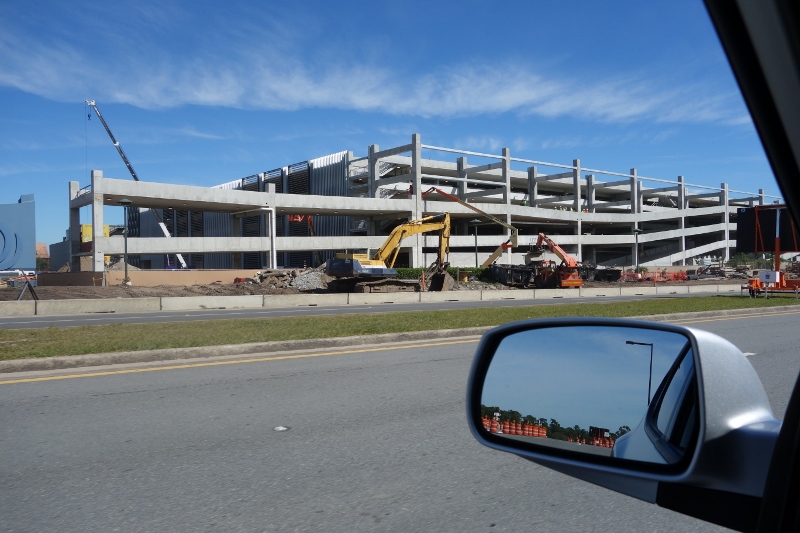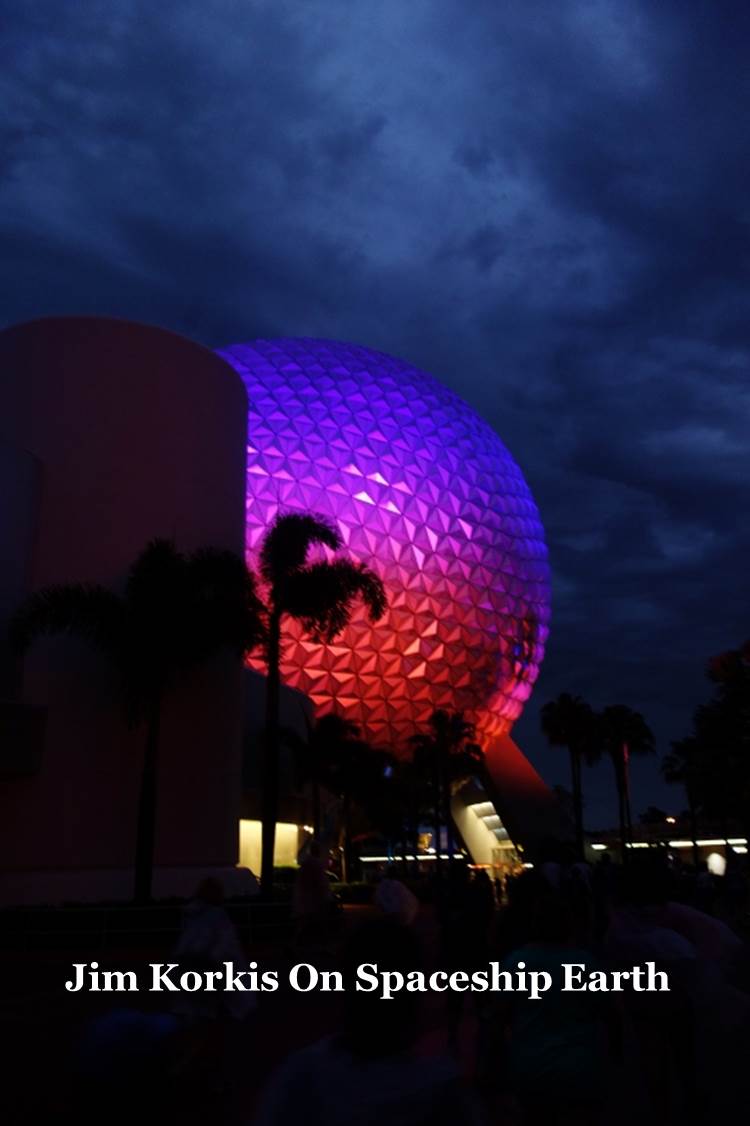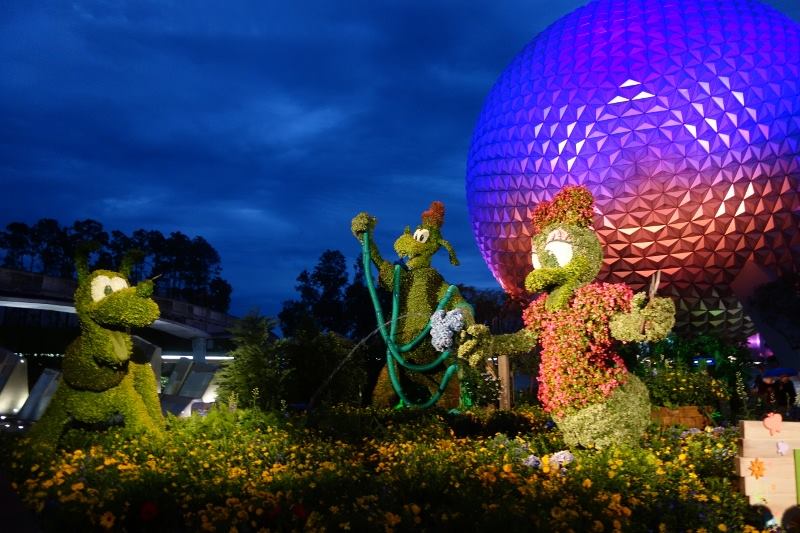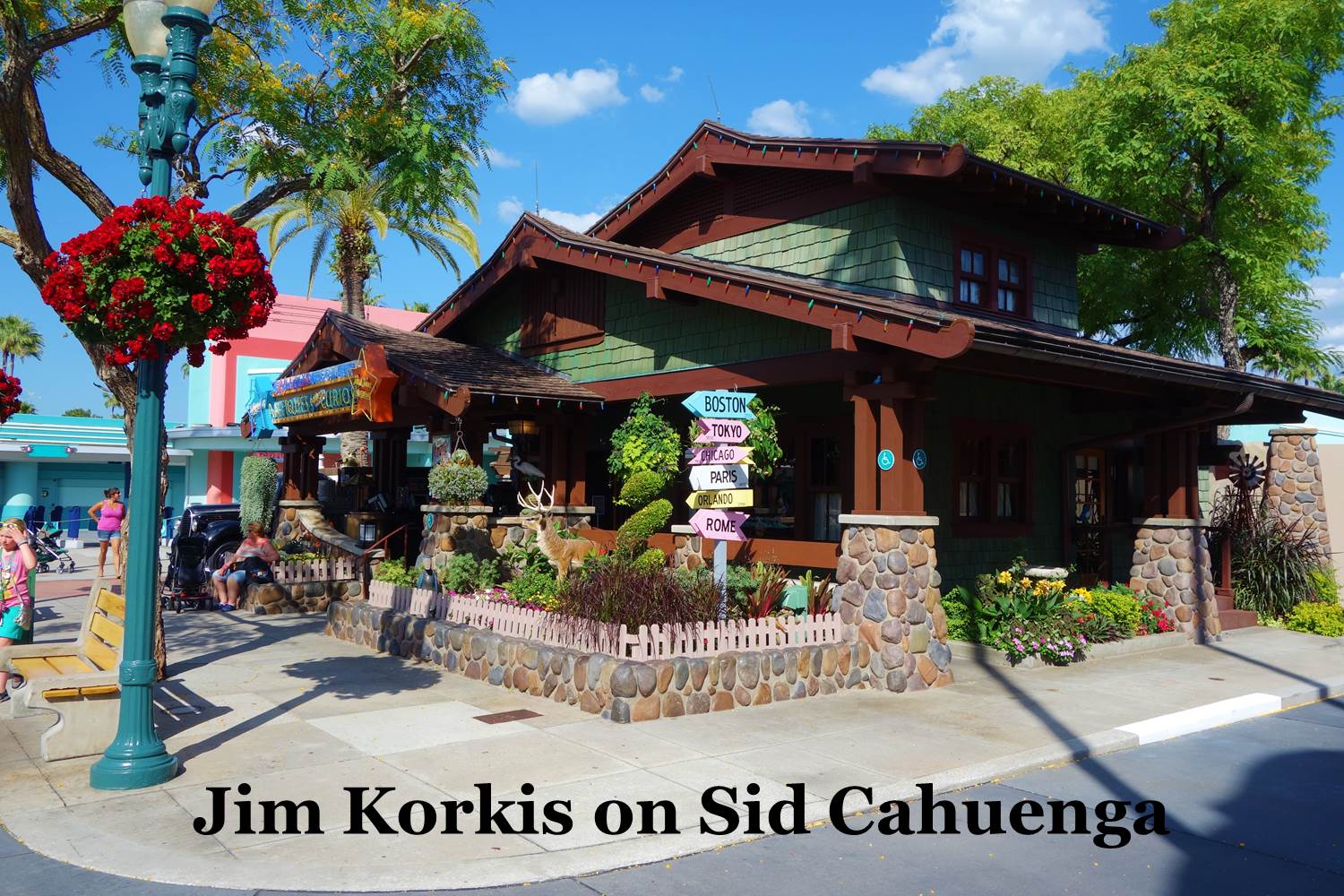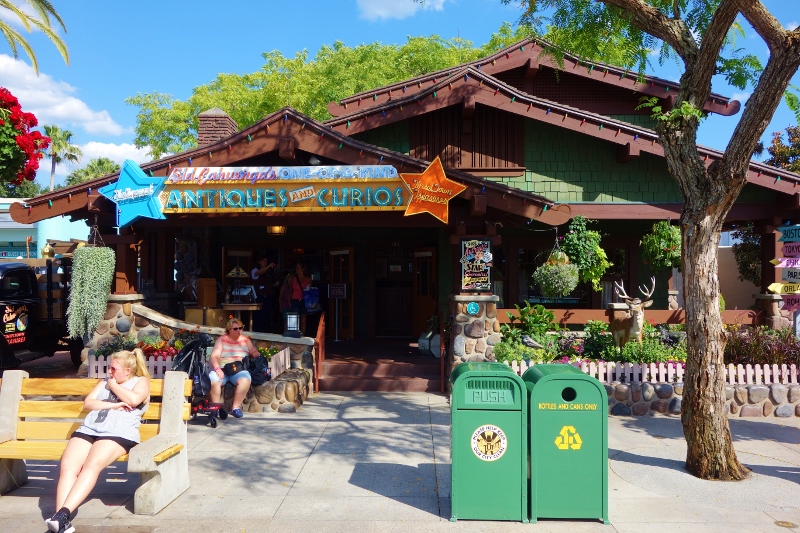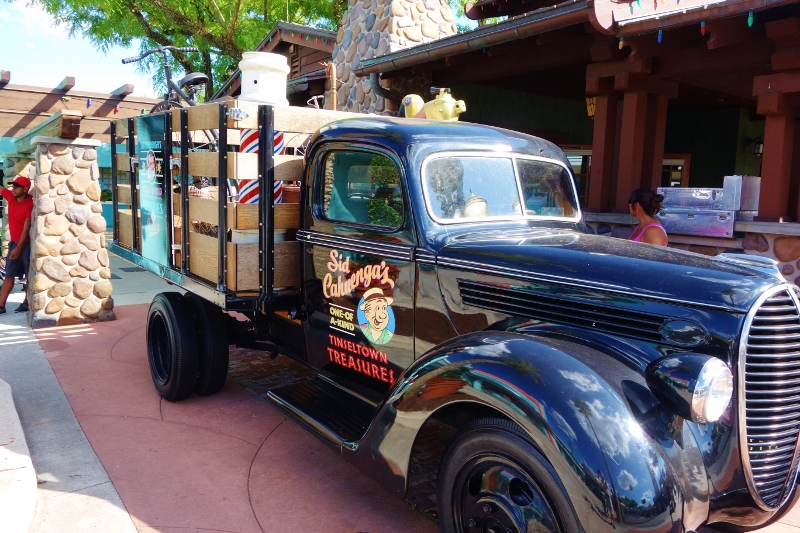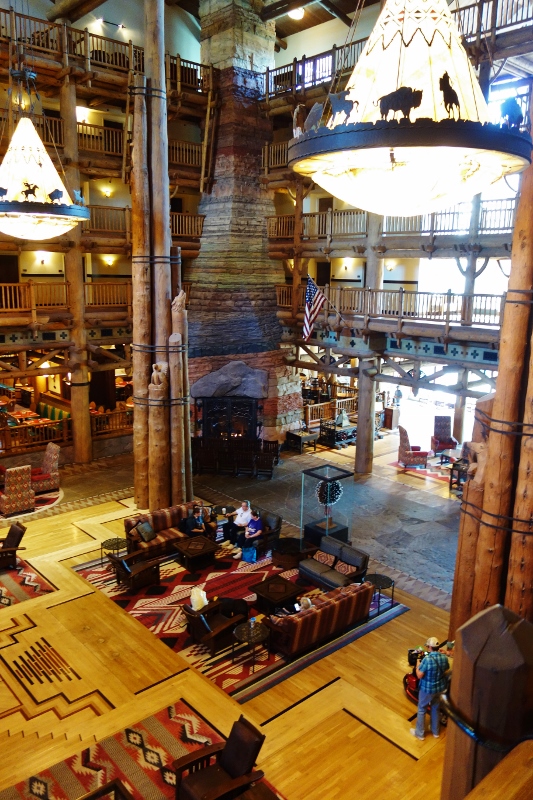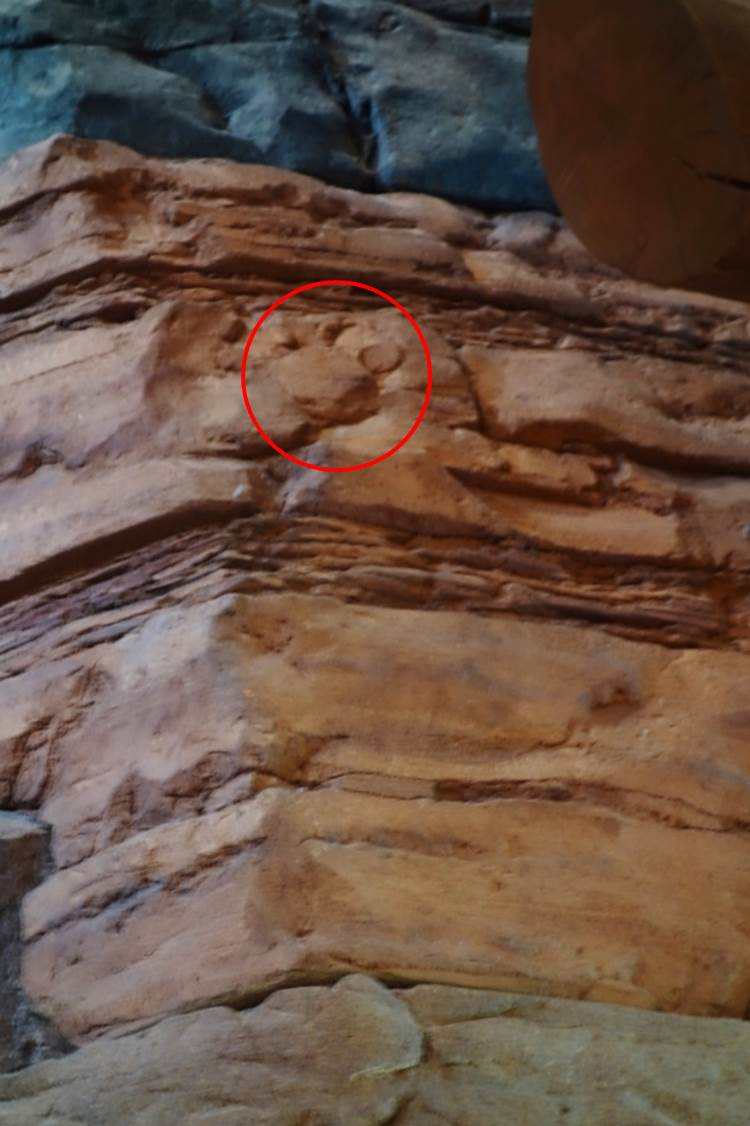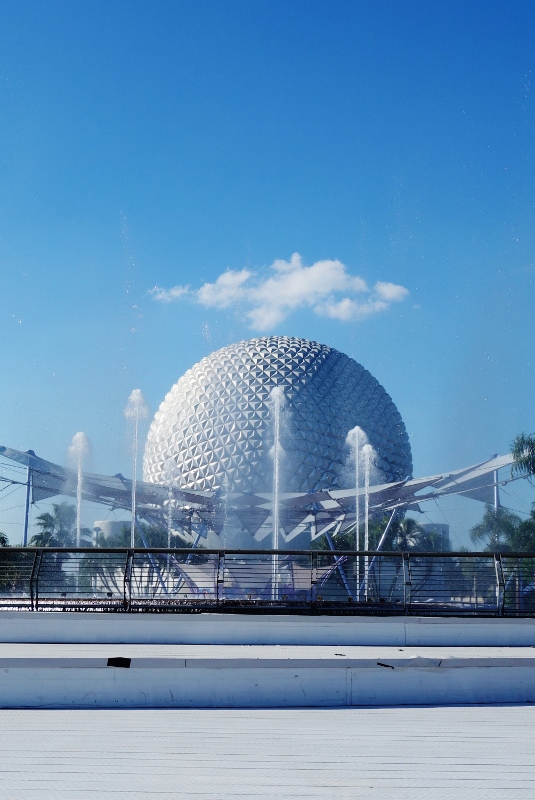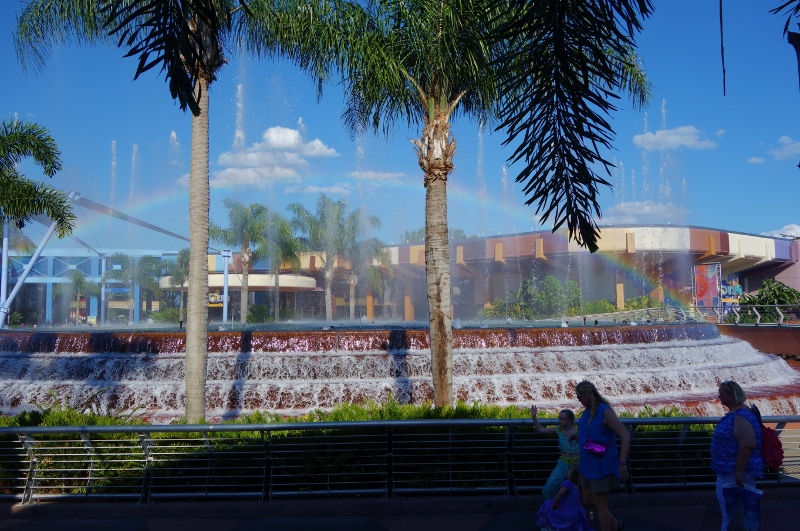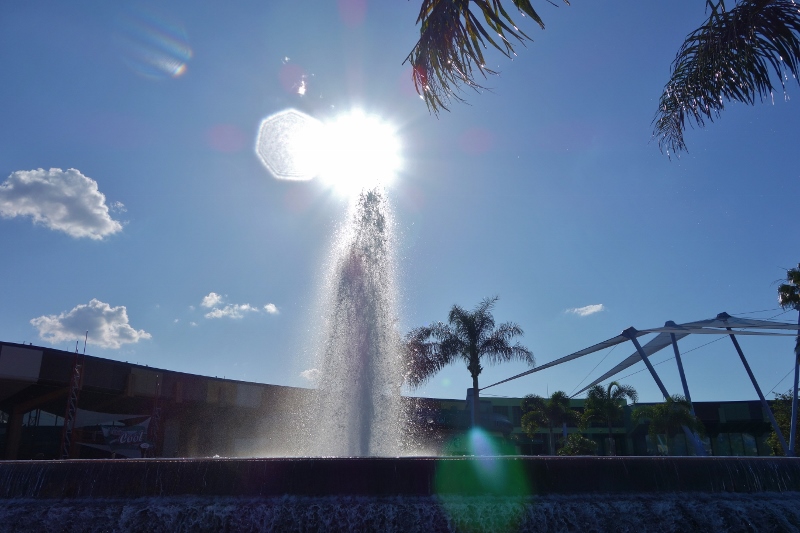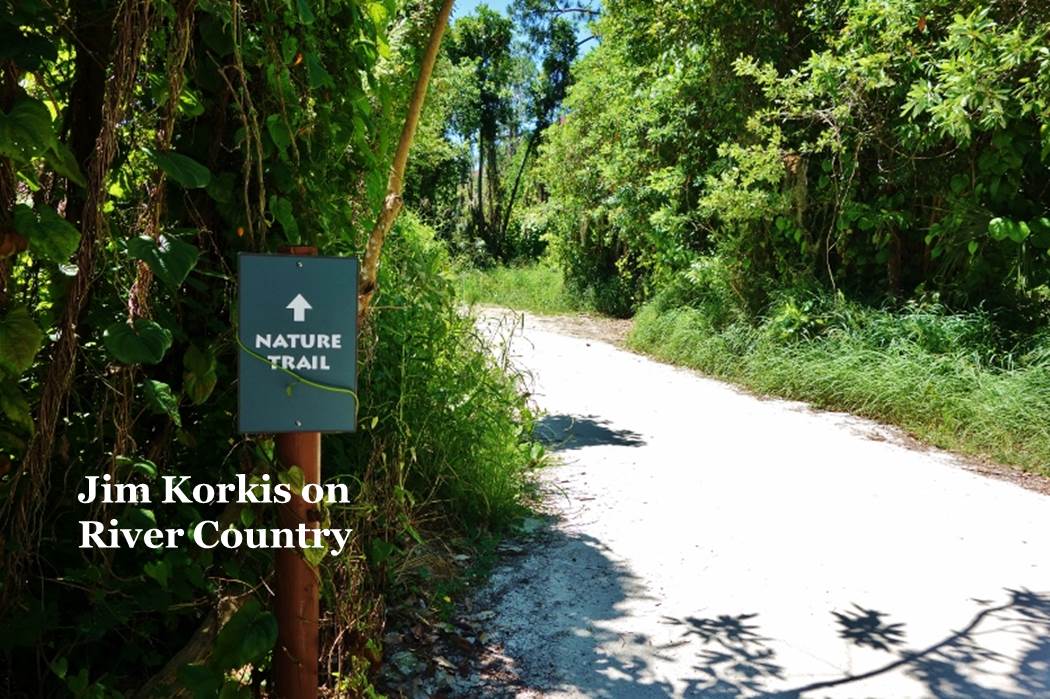Category — A Friday Visit with Jim Korkis
A Friday Visit With Jim Korkis: Downtown Disney
Welcome back to Fridays with Jim Korkis! Jim, the dean of Disney historians and author of Jim’s Gems in The easy Guide, writes about Walt Disney World history every Friday on yourfirstvisit.net.
DOWNTOWN DISNEY: IN THE BEGINNING
By Jim Korkis

Walt Disney World actually has two small communities on property, Lake Buena Vista and Bay Lake, as a way—along with the Reedy Creek Improvement District—for it to control rules and regulations affecting its property.
The former Blake Lake was renamed Lake Buena Vista in 1969 with incorporation of that town of the same name just up the street. (This lake still borders the Preview Center building, which is now the home of the Amateur Athletic Union on Hotel Plaza Boulevard.)
The name Buena Vista was chosen for its Disney connection not only to the name of the film distribution company that released the Disney films but also the name of the street in Burbank where the Disney Studios and corporate offices are located. Buena Vista is Spanish for “good view.”
The canal system here was widened into a large lake, called the Village Lagoon, and in 1974, just a few years after the opening of the Magic Kingdom, the Disney Company built in the area a collection of vacation villas, treehouse villas, and a golf course that became the Disney Village Resort.
The area would later evolve into the Disney Institute and now the Disney Vacation Club’s Disney’s Saratoga Springs Resort and Spa.
Right across the Village Lagoon from the Disney Village Resort was a small shopping area.
When it opened on March 22, 1975, The Lake Buena Vista Shopping Village was immediately popular with guests, locals and business people as a location where they could purchase Disney merchandise and enjoy the Disney magic and quality service without having to pay to get into the Magic Kingdom or stay at one of the Disney resorts.
It was a quiet, soothing small-town atmosphere where visitors could leisurely dine and shop and be entertained. It was a charming retail community surrounding the lake with a barber, post office, art gallery, pottery shop, candle shop, and pharmacy, as well as other simple businesses.
Eventually it was renamed the Disney Village Marketplace and then it became the Downtown Disney Marketplace with the 1989 adjacent expansion into Pleasure Island, a location that mimicked the popular downtown Orlando Church Street where themed restaurants and clubs operated.
The Pleasure Island area has since been shut down, and is now being transformed as part of the redevelopment of Downtown Disney into Disney Springs.
The original Lake Buena Vista Shopping Village had four places to eat: Lite Bite, Heidelberger’s Deli, The Village Restaurant and Cap’n Jack’s (named after Disney Legend Jack Olsen who had a fondness for sailing and fishing and was instrumental in the development of Disney theme park merchandise beginning with Disneyland in 1955). All of these locations no longer exist.
Guests could also take a boat from Cruise Dock West to the Lake Buena Vista Club, where they could enjoy breakfast, lunch, and brunch, as well as French cooking at night.
The Downtown Disney area was meant to be a quiet friendly oasis in the hectic and sometimes chaotic world of Disney. However, today it is as active and often as crowded as any of the WDW theme parks–and under extensive construction.
* * * * *
Thanks, Jim!
Come back next Friday for more from Jim Korkis.
In the meantime, check out his books, including The Vault of Walt, Who’s Afraid of the Song of the South?, and The Book of Mouse
, and his contributions to The easy Guide to Your First Walt Disney World Visit, all published by Theme Park Press.
MORE DISNEY WORLD HISTORY POSTS FROM JIM KORKIS
- “Summer Magic” on Main Street
- Muppets and Mama Melrose
- Peter Dominick and the Wilderness Lodge
- Dixie Landing and Port Orleans Riverside
- The History of Splash Mountain
- The First Disney World Hotel
- The “Sharing the Magic” Statue
- The First Disney World Monorails
- The Water Park River Country
- The Epcot Fountain
- The Fireplace at the Wilderness Lodge
- Sid Cahuenga at Disney’s Hollywood Studios
- Spaceship Earth
- Downtown Disney
- The Missing Resort Hotels
- Echo Park and Echo Lake
- Typhoon Lagoon
Follow yourfirstvisit.net on Facebook or Google+ or Twitter or Pinterest!!
June 12, 2015 2 Comments
A Friday Visit With Jim Korkis: Spaceship Earth
Welcome back to Fridays with Jim Korkis! Jim, the dean of Disney historians and author of Jim’s Gems in The easy Guide, writes about Walt Disney World history every Friday on yourfirstvisit.net.
SPACESHIP EARTH AT EPCOT
By Jim Korkis

The term “Spaceship Earth” was popularized by Buckminister Fuller who was a designer, inventor and early environmental activist.
Fuller envisioned that the planet, like a spaceship, continues to travel through the universe and we as the crew must work together to keep the spaceship in good shape.
Fuller also developed the intrinsic mathematics for a geodesic dome and received a patent for it in 1954.
Spaceship Earth is the largest geodesic sphere in the world at 165 feet in diameter. It is 180 feet to the top and is covered by 954 triangular panels of alucobond (anodized aluminum on both sides heat-bonded with a polyethylene core in the center). It is supported fifteen feet off the ground by six steel legs driven deep into the ground. The structure seems to be floating off the ground.
Imagineer John Hench told reporter Laura Kavesh for her story in The Orlando Sentinel that “the columns of Spaceship Earth are constructed to reach out like beckoning arms. I defy anyone who is depressed to still be depressed when they walk through there. We do all this from experience. Walt did it from intuition. It’s designed to say, ‘You’re okay. You’re going to be okay’. We as humans must make sense of things or we feel threatened.”
Spaceship Earth is actually two separate spherical structures, one inside the other. The inner sphere is composed of 1,450 structural steel members arranged in a giant triangular fashion and is the weatherproof enclosure for the show. The inner core also contains decking at several levels and a spiral route for Spaceship Earth’s ride system.
The outer sphere façade is held about two feet away from the inner core by aluminum hubs. A gutter was developed about mid-point on the sphere to collect rain water and channel it through the structure and its supporting legs to underground drains that eventually lead to the World Showcase lagoon. In that way, rain does not cascade down the side of Spaceship Earth onto the guests below.
To minimize air-conditioning costs, air cannons direct cool air only onto the 1,552 feet ride path so that guests don’t feel the heat and humidity just a few feet away.
Before Disney decided on a geodesic sphere, other designs were considered for Spaceship Earth. These included the Roman Parthenon, the dome of Saint Peter’s Cathedral in the Vatican, and a steel frame supporting a map of the world like that at the 1964-65 New York World’s Fair. A golden geodesic dome was also seriously considered, inspired by the Expo ’67 dome in Montreal.
The attraction was officially dedicated on October 1, 1982, when Epcot first opened to the public. Chairman of Walt Disney Productions Card Walker said, “communications is the beginning of understanding and thus fitting of the park’s marquee attraction.”
In less than a week, over 100,000 guests rode the attraction. Within the first year of operation nearly 7.5 million guests rode Spaceship Earth, letting it claim the honor of the highest ridership of any attraction at all of Walt Disney World that year.
* * * * *
Thanks, Jim!
Come back next Friday for more from Jim Korkis.
In the meantime, check out his books, including The Vault of Walt, Who’s Afraid of the Song of the South?, and The Book of Mouse
, and his contributions to The easy Guide to Your First Walt Disney World Visit, all published by Theme Park Press.
MORE DISNEY WORLD HISTORY POSTS FROM JIM KORKIS
- “Summer Magic” on Main Street
- Muppets and Mama Melrose
- Peter Dominick and the Wilderness Lodge
- Dixie Landing and Port Orleans Riverside
- The History of Splash Mountain
- The First Disney World Hotel
- The “Sharing the Magic” Statue
- The First Disney World Monorails
- The Water Park River Country
- The Epcot Fountain
- The Fireplace at the Wilderness Lodge
- Sid Cahuenga at Disney’s Hollywood Studios
- Spaceship Earth
- Downtown Disney
- The Missing Resort Hotels
- Echo Park and Echo Lake
- Typhoon Lagoon
Follow yourfirstvisit.net on Facebook or Google+ or Twitter or Pinterest!!
June 5, 2015 No Comments
A Friday Visit With Jim Korkis: Sid Cahuenga
Welcome back to Fridays with Jim Korkis! Jim, the dean of Disney historians and author of Jim’s Gems in The easy Guide, writes about Walt Disney World history every Friday on yourfirstvisit.net.
SID CAHUENGA AT DISNEY’S HOLLYWOOD STUDIOS
By Jim Korkis

While today the location is a MyMagic+ Service Center, it originally sold items that included posters of Disney movies, black and white portrait photos of Walt Disney, pressbooks from Disney films, celebrity autographed photos, books, costuming and more.
In fact, for sixteen years up to 2005, guests had the opportunity to meet and have their pictures taken with the friendly Sid Cahuenga himself. Actually, Sid was talented performer Danny Dillon, whose signed and framed photo once hung prominently just inside the establishment’s front door.
Dillon, who passed away at the age of eighty-two, was so iconic as Sid that the role was never replaced after his passing.
The name “Sid” was inspired by iconic showman Sid Grauman who owned and operated Grauman’s Chinese Theater on Hollywood Boulevard as well as other popular movie theaters. The name “Cahuenga” came from Cahuenga Boulevard, a major cross street that leads directly into the heart of Hollywood.
According to the Disney Imagineering created back story, Sid Cahuenga was a big movie fan. With his wife, they relocated from the Midwest to the Hollywood of the 1920s where they bought some land and built their small home.
Unlike other buildings at Disney Hollywood Studios, it is not based on any particular building but rather is faithful to a style associated with that time period, and also mimics the story of the Janes House.
The real Janes House was built in 1903 on Hollywood Boulevard, and rather than ebbing razed and a new building built on its lot, it was turned into a business and other commercial structures were built around it.
The Cahuenga house is themed to a similar story. Once Hollywood grew in the area where the house was built, real estate developers tried desperately to buy the now valuable property from Sid, but he continually refused. He and his wife did not want to move and they liked their new situation in the heart of all the expanded activity.
With a steady stream of tourists and shoppers now filling the street, Sid decided to make some extra money by displaying his collection of movie memorabilia he had accumulated over the years.
He placed the movie collectible items for sale on his front porch and front yard just like an expensive garage sale. He was so successful that he expanded his business by transforming a few rooms in the front of his house into a store. He propped up items on bureaus, tables and even the fireplace.
He realized he needed to replenish the one-of-a-kind items he was selling so he got a large black flatbed truck, often parked next to his home.
He would use the vehicle to buy surplus items from the studios or rummage through dumpsters behind the studios to recover items that had been thrown away.
Look in the back of the truck and see some interesting items including a figure from the Magic Kingdom’s defunct 20,000 Leagues Under the Sea attraction.
He had made many friends in the twenty years he had lived in Hollywood and some of those stars were only to happy to sign photos or give things to Sid which he promptly put up for sale.
Sid and his wife made a good living for decades until their passing.
* * * * *
Thanks, Jim!
Come back next Friday for more from Jim Korkis.
In the meantime, check out his books, including The Vault of Walt, Who’s Afraid of the Song of the South?, and The Book of Mouse
, and his contributions to The easy Guide to Your First Walt Disney World Visit, all published by Theme Park Press.
MORE DISNEY WORLD HISTORY POSTS FROM JIM KORKIS
- “Summer Magic” on Main Street
- Muppets and Mama Melrose
- Peter Dominick and the Wilderness Lodge
- Dixie Landing and Port Orleans Riverside
- The History of Splash Mountain
- The First Disney World Hotel
- The “Sharing the Magic” Statue
- The First Disney World Monorails
- The Water Park River Country
- The Epcot Fountain
- The Fireplace at the Wilderness Lodge
- Sid Cahuenga
- Spaceship Earth
- Downtown Disney
- The Missing Resort Hotels
- Echo Park and Echo Lake
- Typhoon Lagoon
Follow yourfirstvisit.net on Facebook or Google+ or Twitter or Pinterest!!
May 29, 2015 4 Comments
A Friday Visit With Jim Korkis: The Fireplace at Disney’s Wilderness Lodge
Welcome back to Fridays with Jim Korkis! Jim, the dean of Disney historians and author of Jim’s Gems in The easy Guide, writes about Walt Disney World history every Friday on yourfirstvisit.net.
THE FIREPLACE AT DISNEY’S WILDERNESS LODGE
By Jim Korkis

The fireplace is based on that at the Bright Angel Lodge at the Grand Canyon which has a small geologic fireplace that was quarried directly from the layers of the Grand Canyon.
But the WDW Imagineers went for a more dramatic storytelling version for the Wilderness Lodge.
The fireplace is an intricate 82 foot high replica of the Grand Canyon’s South Rim strata. As you ascend the levels of the lobby, you travel upward to modern times.
To see evidence of the first creatures to squirm over and under the surface of the earth, guests should go to the Wilderness Lodge’s fourth floor and search the layers of Tapeats Sandstone for worm borrows and trilobite trails.
Disney sent paleontologist (and artist) Robert Reid to study the actual walls of the Grand Canyon.
His studies were reproduced in a detailed book that was used to help contractors create the fireplace replete with a kaleidoscope of colors, rocks and fossils—many of which are real.
Some of the fossils of prehistoric plant and animal life are several hundred millions years old and are carefully embedded in the correct stratus for a historically accurate view. They pre-date the dinosaur era.
Over 100 colors in hues of green, magenta, buff, red, black and brown are visible. From the Vishnu Schist to Bass Limestone to Tapeats Sandstone to the Redwall and Temple Butte Limestone and finally ending with Kaibab Limestone and Toroweap Formation, the fireplace represents the 1.6 billion years of the time it took for the layers of rock to form.
The variations are recreated in the same proportions as those that appear in the real Grand Canyon that range from 50 to 700 feet thick.
The Fireplace is built to scale with the geologic layout of the Grand Canyon, complete with geologic disconformities (periods of deposition, erosion, tilting and renewed deposition on top of the older rocks). The detail is nearly perfect with the textbook diagrams documenting the geology of the Grand Canyon.
Samples of elements from each strata are housed in glass display cases near the fireplace on each floor level. These displays describe the epoch that section of the fireplace rock represented.
One of the things that does not exist in the real Grand Canyon is a Hidden Mickey but one does exist in the Wilderness Lodge fireplace.
Directly facing the fireplace, on the right hand side of the three-sided fireplace where a lodgepole is jutting out before the next floor and in the reddish rock is the famous three circled Mickey Mouse head.
At the Guest Services front desk, guests can get a riddle clue sheet to help them locate the over two dozen Hidden Mickeys at the Wilderness Lodge Resort.
By the way, the Wilderness Lodge fireplace is a real working fireplace. Originally, it burned wood, which caused several challenges over the early years, including raising the humidity level in the lobby that led to cracking the wood used in the massive totem poles.
It was converted to a gas burning fireplace for a number of reasons including the fact that gas is safer and can be more easily controlled.
* * * * *
Thanks, Jim! For more on the Wilderness Lodge, see this. And come back next Friday for more from Jim Korkis.
In the meantime, check out his books, including The Vault of Walt, Who’s Afraid of the Song of the South?, and The Book of Mouse
, and his contributions to The easy Guide to Your First Walt Disney World Visit, all published by Theme Park Press.
MORE DISNEY WORLD HISTORY POSTS FROM JIM KORKIS
- “Summer Magic” on Main Street
- Muppets and Mama Melrose
- Peter Dominick and the Wilderness Lodge
- Dixie Landing and Port Orleans Riverside
- The History of Splash Mountain
- The First Disney World Hotel
- The “Sharing the Magic” Statue
- The First Disney World Monorails
- The Water Park River Country
- The Epcot Fountain
- The Fireplace at the Wilderness Lodge
- Sid Cahuenga at Disney’s Hollywood Studios
- Spaceship Earth
- Downtown Disney
- The Missing Resort Hotels
- Echo Park and Echo Lake
- Typhoon Lagoon
Follow yourfirstvisit.net on Facebook or Google+ or Twitter or Pinterest!!
May 22, 2015 No Comments
A Friday Visit With Jim Korkis: The Epcot Fountain
Welcome back to Fridays with Jim Korkis! Jim, the dean of Disney historians and author of Jim’s Gems in The easy Guide, writes about Walt Disney World history every Friday on yourfirstvisit.net.
THE EPCOT FOUNTAIN
By Jim Korkis

Over the years, the fountain in the middle of Epcot has been called many different names including these titles both on websites and on official Disney Company press releases.
Whatever guests and cast members call the fountain, it is often used as a central meeting place landmark, and as a photo location with SpaceShip Earth majestically looming in the background.
The iconic fountain has been a part of Epcot since opening day in October 1982. In fact, as a symbolic gesture of international cooperation and understanding, representatives from 22 countries each poured a gallon of water from their homelands into the fountain during the dedication ceremony of the park.
Today, every fifteen minutes, the fountain showcases water ballets where over two hundred shooters propel water up to one hundred and fifty feet in the air.
There are seven different musical selections that rotate:
- Instrumental from the “Air Battle” sequence from “Surprise in the Skies” a former daytime lagoon show at Epcot
- “Day One” by John Tesh
- Main title selection from the Disney live-action feature film “Iron Will”
- “Mickey’s Finale” selection from a proposed Epcot show tentatively titled “Around the World with Mickey Mouse”
- Selection from Disney’s animated feature “The Rescuers Down Under”
- Selection from the Disney live-action feature film “The Rocketeer,” and
- “Standing in Motion” by Yanni
It took three months of computer programming to design the seven different water ballets. At night, over a thousand colored lights highlight the streams of water. It is the largest fountain on Disney property.
The fountain holds approximately one hundred and fifty thousand gallons of water with computer controlled pumps sending almost thirty thousand gallons of water per minute cascading down its tiered walls.
The fountain uses almost thirty-five miles of electrical wire. Chloride is too corrosive for this fountain, so Disney uses bromine to keep it clean and to ensure that no algae develops. The coins that are retrieved from this fountain, like others on property, are donated by the Disney Company to local charities.
Running underneath the entire fountain is an underground work area that houses the pumps and computer systems, as well as a workshop for cast members who maintain the Epcot fountains. There is also a space with special lifts that are used beneath the stage area for performers and equipment.
The underground work area was built, and then the fountain placed on top, with no planning on how to get new equipment down into the area. Over the years, the fountain has been damaged, like when a temporary stage for performing elephants was put on top of it when Epcot showcased a daily circus.
In the 1980’s the fountain team at Walt Disney World included a young civil engineer whose thesis was on the behavior of turbulence-free water. That young engineer, Mark Fuller, worked on the Epcot fountain, and later founded WET Design. This company became the premiere fountain company in the world.
Mark Fuller is also responsible for other Disney fountains including the leapfrog fountain at the Imagination pavilion. His greatest creation to date may be at the Bellagio Hotel in Las Vegas.
* * * * *
Thanks, Jim! Come back next Friday for more from Jim Korkis.
In the meantime, check out his books, including The Vault of Walt, Who’s Afraid of the Song of the South?, and The Book of Mouse
, and his contributions to The easy Guide to Your First Walt Disney World Visit, all published by Theme Park Press.
MORE DISNEY WORLD HISTORY POSTS FROM JIM KORKIS
- “Summer Magic” on Main Street
- Muppets and Mama Melrose
- Peter Dominick and the Wilderness Lodge
- Dixie Landing and Port Orleans Riverside
- The History of Splash Mountain
- The First Disney World Hotel
- The “Sharing the Magic” Statue
- The First Disney World Monorails
- The Water Park River Country
- The Epcot Fountain
- The Fireplace at the Wilderness Lodge
- Sid Cahuenga
- Spaceship Earth
- The Missing Resort Hotels
- Echo Park and Echo Lake
- Typhoon Lagoon
Follow yourfirstvisit.net on Facebook or Google+ or Twitter or Pinterest!!
May 15, 2015 3 Comments
A Friday Visit With Jim Korkis: The First Disney World Water Park
Welcome back to Fridays with Jim Korkis! Jim, the dean of Disney historians and author of Jim’s Gems in The easy Guide, writes about Walt Disney World history every Friday on yourfirstvisit.net.
THE ORIGINAL WALT DISNEY WORLD WATER PARK
By Jim Korkis
“River Country! Big River Country.
It’s a hoot. It’s a holler! It’s a water jamboree!
River Country. Big River Country.
If you’re hot around the collar it’s the cool place to be!”

Walt Disney World defined the concept of a themed water park with the opening of Disney’s River Country on June 20, 1976 as part of the Fort Wilderness Resort on the shore of Bay Lake.
Originally, this water park was going to be called “Pop’s Willow Grove” and was meant to be reminiscent of “an old fishing hole” from the time period of Tom Sawyer and Huck Finn, with items like rope swings enhancing that story.
River Country was about one-fourth the size of the later-built Typhoon Lagoon, since the Disney Company had no idea whether such a then radical idea would be successful.
Attractions included a 330,000 gallon clear water pool called Upstream Plunge, Slippery Slide Falls, two sixteen foot rock slides with faux rock work (scattered with pebbles from streambeds in Georgia and the Carolinas) done by Imagineer Fred Joerger (who did rock work on everything from the Jungle Cruise’s Schweitzer Falls to Big Thunder Mountain), and the Ol’ Swimmin’ Hole, dedicated by President Gerald Ford’s daughter, Susan.
The Ol’ Swimmin’ Hole had Whoop-n-Holler Hollow, two long winding chutes that ended with a splashing entry into the water.
Water from nearby Bay Lake was pumped through the inside of River Country’s artificial mountain to the top of the flumes and raft ride at the rate of 8,500 gallons a minute and then eventually through the miracle of gravity spilled back into the lake.
There was a natural soft sand beach underfoot the massive pool rather than a concrete bottom, which was a unique innovation at the time.
Even with the filtration system, the water from the lake was not completely purified and that caused some red flags for Disney Legal.
Its huge popularity resulted in many sold out days, since the Walt Disney World water park had limited capacity. It became apparent that a larger water park facility was needed but it took just over a decade for it to become a reality.
Typhoon Lagoon opened on June 1, 1989 just across the street from the newly built Pleasure Island, and was home to the world’s largest outdoor surf pool (not just a wave pool). It was part of the 1989 expansion of Walt Disney World that also saw the opening down the street of the Disney MGM Studios theme park. Typhoon Lagoon proved so popular that in 1995 a third water park, Blizzard Beach, was opened to accommodate the demand.
These new options led to a drop in attendance at the more difficult to access River Country. In 1998, the water park tried to compete with the “All-American Water Party” promotion where every day was celebrated as the Fourth of July with games, Disney characters in country costumes, live country music and good old fashioned barbeque.
In September 2001, River Country quietly closed at the end of the summer season and never re-opened. In 2002, Walt Disney World spokesman Bill Warren told the Orlando Sentinel newspaper that River Country could be reopened if ‘there’s enough guest demand”.
Even today, over a decade later, the decaying ruins of the innovative water park remain but are hidden behind walls and are off-limits to current Disney guests.
* * * * *
Thanks, Jim! There’s a walkway between the Wilderness Lodge and Fort Wilderness that I’ve hiked many a time–it’s a very peaceful spot. Somewhere it must cut through the old River Country space–but I’ve never noticed where.
Come back next Friday for more from Jim Korkis. In the meantime, check out his books, including The Vault of Walt, Who’s Afraid of the Song of the South?, and The Book of Mouse
, and his contributions to The easy Guide to Your First Walt Disney World Visit, all published by Theme Park Press.
MORE DISNEY WORLD HISTORY POSTS FROM JIM KORKIS
- “Summer Magic” on Main Street
- Muppets and Mama Melrose
- Peter Dominick and the Wilderness Lodge
- Dixie Landing and Port Orleans Riverside
- The History of Splash Mountain
- The First Disney World Hotel
- The “Sharing the Magic” Statue
- The First Disney World Monorails
- The Water Park River Country
- The Epcot Fountain
- The Fireplace at the Wilderness Lodge
- Sid Cahuenga
- Spaceship Earth
- The Missing Resort Hotels
- Echo Park and Echo Lake
- Typhoon Lagoon
Follow yourfirstvisit.net on Facebook or Google+ or Twitter or Pinterest!!
May 8, 2015 No Comments

